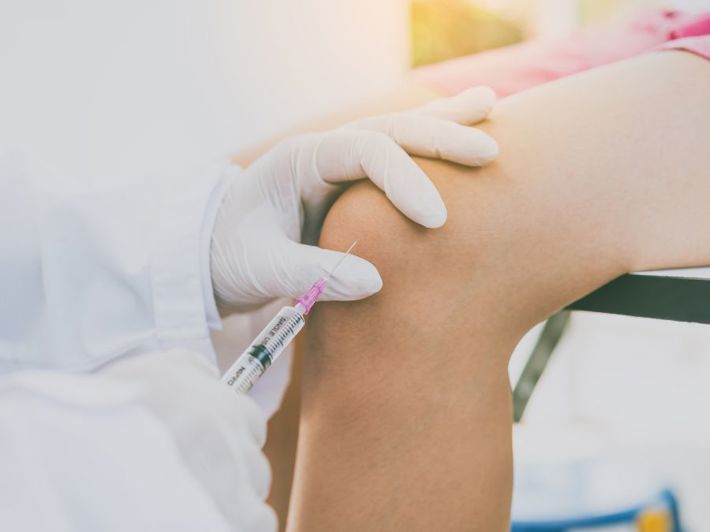Doctors may recommend injections to manage knee osteoarthritis pain when painkillers or physical therapy aren’t effective enough. Injections like corticosteroids or hyaluronic acid (gel or lubricating injections) can be administered directly into the joint to reduce inflammation and relieve pain. Other injection options, like PRP (platelet-rich plasma) or stem cells, may help ease pain while also supporting cartilage regeneration. (1)
Best Injections for Knee Osteoarthritis
Several injection options are available for treating knee osteoarthritis, but according to the American Academy of Orthopaedic Surgeons (AAOS), corticosteroid injections remain the most recommended and preferred treatment.
Other types may help certain patients, but they are still being studied and therefore used less frequently. (2)
Here’s a breakdown of each type of injection and what is currently known about its effectiveness:
Corticosteroid Injections
Corticosteroid injections are effective at easing sudden pain flare-ups and inflammation, especially when fluid accumulates inside the joint. These injections reduce symptoms by calming inflammation, though they are not a permanent solution and are recommended only for short-term relief of severe knee pain when other treatments fall short. (3)(4)
Key Points:
- Fast-acting: Pain relief typically begins within a day or two after the injection.
- Duration of relief: Effects generally last 6 to 12 weeks, which is often long enough for a flare-up to subside, though results may vary from person to person.
- Not for continuous use: The first injection tends to work best. Repeated use may reduce effectiveness and increase risk, so they’re typically limited to 3–4 injections per year, with at least three months between injections. Overuse can weaken joint cartilage.
- Side effects: May include pain and swelling at the injection site, permanent skin lightening, and in some cases, muscle or tendon weakness.
Hyaluronic Acid Injections
(Gel or Viscosupplement Injections)
Healthy knee joints naturally contain hyaluronic acid. In osteoarthritis, its levels decrease and the fluid becomes thinner, leading to increased friction and pain. (3)(4)
Key Points:
- Effect: Acts as a lubricant to help reduce friction in the knee. However, its benefit is typically short-lived.
- Usage: Not usually the first-line treatment. It may be suggested if NSAIDs or corticosteroids aren’t effective or cannot be used.
- Effectiveness: Considered less effective than corticosteroids. Evidence is mixed—some studies report modest benefits, while others show little to no improvement. Patient response varies.
- Injection schedule: Depends on the product. Some require one injection, while others are administered weekly for up to 5 weeks. Common brands include Synvisc, Hyalgan, and Durolane.
- Side effects: Usually mild, such as joint pain, redness, or swelling. Generally low-risk as hyaluronic acid is a natural substance in the body.
Platelet-Rich Plasma (PRP) Injections
PRP therapy has gained popularity as a potential regenerative treatment—not just for pain relief but also for promoting cartilage healing. (3)(4)
Key Points:
- Effect: PRP is created by drawing a small amount of the patient’s blood, processing it to concentrate the platelets, and reinjecting it into the knee. Platelets release natural growth factors that may promote tissue repair. However, PRP can also trigger inflammation in some cases.
- Effectiveness: Still inconclusive. Research results are mixed and don’t yet confirm reliable symptom improvement, so it’s not routinely recommended. Additionally, PRP is costly and often not covered by insurance. (5)
- Side effects: Since it uses the patient’s own blood, the risk of serious side effects is minimal.
Stem Cell Injections
Stem cell therapy aims to reduce inflammation and encourage the growth of new cartilage tissue in damaged joints. (1)(3)
Key Points:
- Effect: Stem cells can transform into various types of cells, including those that may help repair damaged cartilage. When injected into an osteoarthritic knee, they may support healing and reduce inflammation.
- Effectiveness: Despite its promise, studies show that few stem cells survive after injection, and benefits remain unproven. It's unclear whether they provide real improvements for knee osteoarthritis.
- Recommendation: Not generally recommended due to limited clinical evidence and safety concerns, according to the U.S. FDA.
Final Word
Currently, corticosteroid injections remain the only injection type widely recommended by medical experts for knee osteoarthritis pain. If they provide some relief but not enough—or if they’re not suitable for a specific case—hyaluronic acid or PRP injections may be considered as alternatives.
At Al-Ahli Hospital's Rheumatology and Joint Care Department, we offer a range of advanced treatments for knee osteoarthritis, including expert-administered injections such as corticosteroids, hyaluronic acid, and PRP—tailored to your condition by our specialized medical team. Book your appointment now.
References
- NYU Langone Health - Therapeutic Injections for Osteoarthritis of the Knee
- The American Academy of Orthopaedic Surgeons - Management of Osteoarthritis of the
- Knee (Non-Arthroplasty)
- NIH NLM - Osteoarthritis of the knee: Learn More – Do knee injections help?
- WebMD - Injectable Medications for Knee Osteoarthritis
- Medscape - Knee Injection






